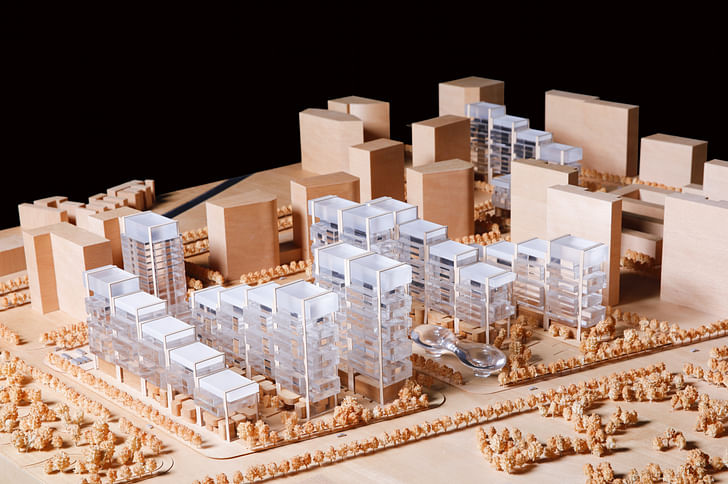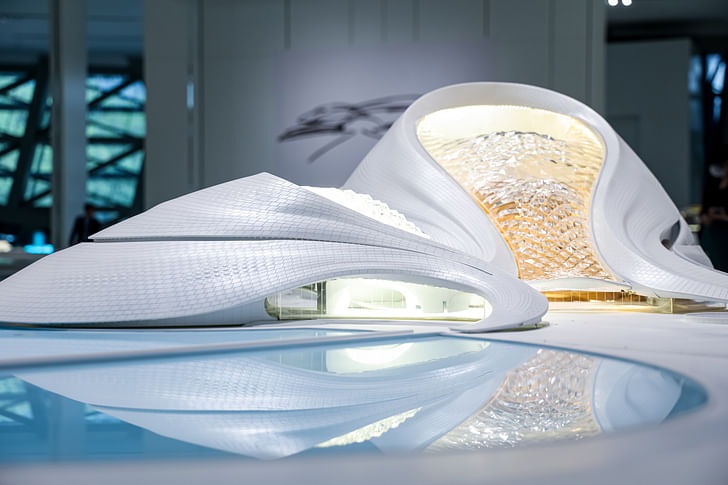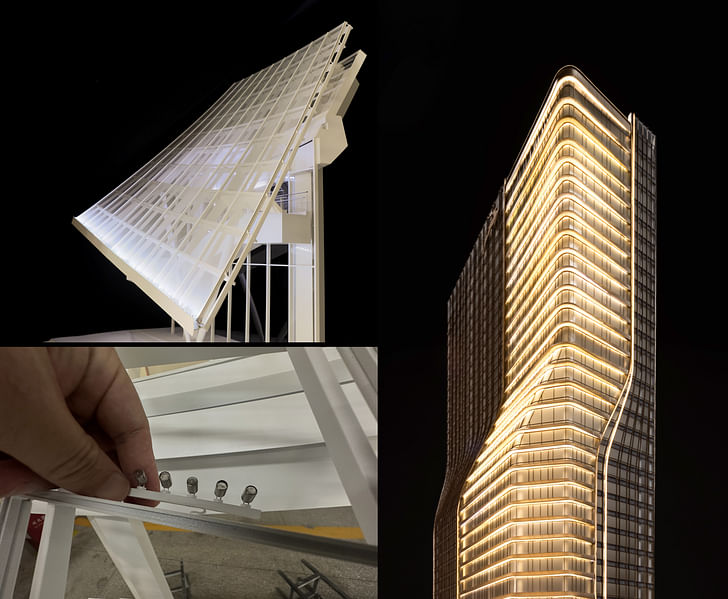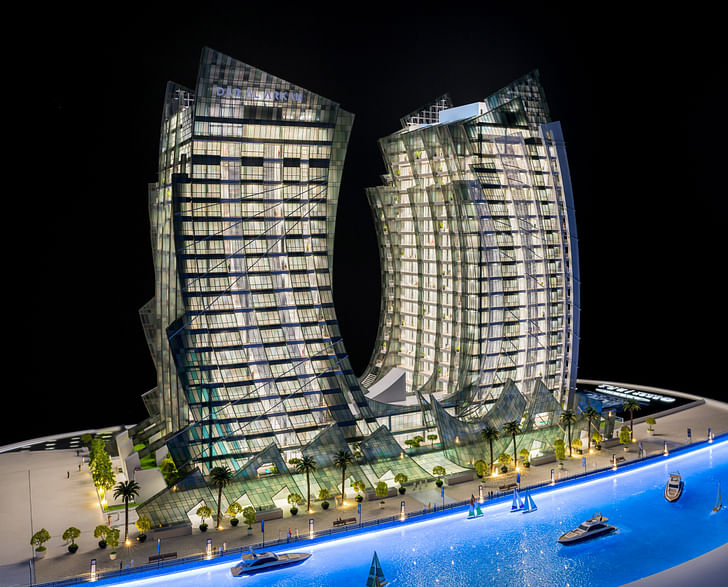Our Terms & Conditions | Our Privacy Policy
How the Architectural Model Maker Behind the Chinese Pavilion at the Venice Biennale Impressed Architects Around the World | Features
Model of Fenix Museum of Migration, scale 1:100. Image credit: MAD
In recent years, the global architecture industry has been challenged by disruptions such as the pandemic and deglobalization, while also undergoing transformation with the emergence of technologies like AI, 3D printing, and automated construction. QZY faces these changes alongside architects, continually exploring and experimenting to find solutions — bringing its own unique perspective to the future of global model-making services.

Urban design by Foster + Partners, scale 1:500. Image credit: QZY Models
Collaborative
Experiments at the Venice Biennale
This
year at the Venice Biennale, QZY Models was entrusted with producing
the complete set of architectural models for the China Pavilion. On a
stage that champions experimentation and provocation, model-making
extends far beyond execution — it becomes a co-creative process
with architects. Each model serves as a distinct investigation into
architectural thought and spatial expression.
Plug-in
Update City
production process. Video credit: QZY Models
One
of the most compelling works was Plug-in
Update City,
a collaboration between PAO (People’s Architecture Office) and
Long Ying Research Group of Tsinghua University. The architects
envisioned a conceptual installation built from salvaged components
of old models, combined with newly 3D-printed green “plug-ins” to
explore ideas of micro-urban renewal. In close coordination with QZY, the team collected, standardized, and integrated hundreds of
discarded model parts within just two weeks. The process was highly
synchronized: While the architects designed on-site at their workshop, one team constructed the road network base, another gathered
model fragments, and a third fabricated the 3D-printed elements.
To
balance sustainability and performance, the team used biodegradable
green PLA (Polylactic Acid) for the 3D-printed components and applied
rigorous pre-drying procedures to ensure material stability. The
final model measured 6 x 4.5 meters. For overseas transport, the base
was modularized along original patchwork, such as roads and rivers,
minimizing visible seams while ensuring structural integrity during
shipment.

12 Rhythms in Liangzhu. Image credit: QZY Models
Another
piece, 12
Rhythms in Liangzhu
by the China Academy of Art, explored the connection between sound
and nature. QZY developed a custom model that incorporated
multimedia equipment, musical instruments, and projection systems.
The main challenge was achieving a floating display that seamlessly
integrated tablets and physical components. They engineered a
standardized interface for electronics, lighting, and later additions
by the creators.
In
City
in China – Nature of All Things
by WAY studio and Tencent Research Institute, QZY fabricated a
nearly three-meter-tall model integrating moss ecosystems, lighting,
misting, and water circulation systems. Suspended via fine steel
wires, the model demanded exceptional strength and airtightness. The
model employed a PETG 3D-printed structure reinforced with steel, its
untreated surfaces promoting moss growth. Structural connections were
reinforced with steel rivets, balancing strength with modular
assembly needs.
Nature
of All Things
production process. Video credit: QZY Models
Do
We Still Need Professional Model Studios in the Era of 3D Printing?
With
3D printing becoming increasingly accessible, many architects now have their own 3D printers for daily use. So, where does that leave
professional model studios?
“Back
in the early 1990s, models in China were predominantly handmade,”
recalls Richie Ren, founder of QZY Models. “Then came laser
cutting, CNC, and 3D printing. I’ve witnessed this evolution
firsthand, but I’ve never felt that these technologies threaten our
craft. On the contrary, especially with 3D printing, our precision
and efficiency have increased exponentially. We now tackle geometries
once thought impossible, freeing model engineers from repetitive
tasks and unlocking new creative possibilities alongside
collaborating architects.”

Harbin Opera House model, remade by QZY Models based on a damaged original, scale 1:150. Image credit: MAD
QZY’s collaborations with MAD frequently incorporate 3D printing.
For instance, the Fenix Museum of Migration and Lucas Arts Centre
would have been nearly impossible to produce without it. But printing
is only the beginning.
For
the Fenix Museum model, MAD sought a realistic material
representation: metal and wood on the viewing platform, concrete and
brick on the former factory. The “tornado” structure on the
observation deck was especially complex, requiring a split assembly
strategy at its junction with the old warehouse. Its final aluminum
finish was achieved through meticulous polishing and electroplating,
while the wooden underside was recreated through hand-painted
detailing. The aged brick walls combined UV printing with manual
colorwork to achieve an authentic weathered appearance.
Fenix
Museum model
production process. Video credit: QZY Models
Secondary
Design for Better Visual Realism
When observing architectural scale models, the viewer does not shrink alongside the model — resulting in perceptual distortions where certain details recede while others become exaggerated. Consider structural beams measuring 5 cm vs. 3 cm in reality: At a 1:100 scale, the 0.5 mm and 0.3 mm representations become optically indistinguishable. To counter this, our studio deliberately amplified the differential to 0.6 mm versus 0.3 mm, or beyond.
To preserve visual clarity, model designers intentionally exaggerate key elements by adjusting thickness, texture, or color saturation, ensuring the design intent remains legible and impactful at scale. To support this, QZY has developed a systematic calibration protocol.
On the Suzhou Hengli Tower model for Foster + Partners, tailoring proportions, material finishes, and color treatments based on how the model would be viewed. This method ensures that the core architectural narrative is not lost but enhanced through the model.

Suzhou Hengli Tower section model, scale 1:30 & 1:50. Image credit: QZY Models
Material
constraints also influence design. For example, making tiny
spotlights under 4 mm is possible at 1:50 scale (as done for the Yiwu
Grand Theater), but not at 1:150. In a UNStudio project, a decorative
strip was originally lit with spotlights in real life. For the scaled
model, QZY Models redesigned the lighting logic: making the receiving
surface glow, effectively hiding the light source while preserving
the spatial quality.
Model-making
demands secondary design — translating form, light, and texture
into miniature sensory experiences.

Lighting strategies in two models: Yiwu Grand Theater model (1:15) VS UNS tower model (1:150). Image credit: QZY Models
Model-Making
as the Art of Substitution
In
Chinese, the word for “model” implies using something simpler to
represent something more complex — hence the idea that model-making
is the art of substitution. When architects begin a model, they tend
to replicate real materials to convey texture and materiality. QZY approaches this process through deep collaboration with the
architect, seeking to understand the design intent while balancing
factors such as feasibility and cost-effectiveness to offer informed
recommendations and deliver the best possible result.
Take,
for instance, the renovation project model for PAO. To capture the
worn character of its concrete walls, the team applied layered
surface treatments and hand-finishing techniques. While they have the capability to work with authentic materials like solid wood
or metal — as in several high-rise models for KPF’s new
headquarters — the team always prioritizes early-stage dialogue. By
aligning with the project’s ultimate goals from the outset, they help identify the most effective and elegant solutions.

Artificially simulated material (PAO renovation project model) vs. Solid wood material (KPF Highrise tower model). Image credit: QZY Models & KPF
Toward
a Global Model-Making Service
Traditionally,
architectural model-making was a localized craft. Architects would
commission nearby workshops and deliver models directly to clients.
However, as expectations for model quality have risen, local vendors
often fall short. With globalization and improved logistics, Chinese
firms — including QZY Models — have tapped into new
opportunities, offering high-quality model-making services on a
global scale. Even during the pandemic, they saw its international business grow rather than decline, thanks to its robust
logistics services and packaging capabilities.

Dubai Dar Al Arkan DaVinci Tower by Pagani, scale 1:100. Image credit: QZY Models
The
Middle East, now a hub for architectural innovation, demands top-tier
global services — including model-making. Richi Ren, founder of QZY
Models, previously worked at a model office in Dubai from 2006 to
2009. After returning to China, he remained active in the region and
later established liaison offices in the Middle East and Europe.
Based
in Shenzhen — an epicenter of design innovation — QZY collaborates with leading firms such as KPF, MAD, Foster + Partners,
Morphosis, NBBJ, RMJM, AECOM, Nikken Sekkei, and AEDAS, contributing to projects worldwide.

Changi Airport Terminal 5, scale 1:500. Image credit: QZY Models
Global
service requires close collaboration and foresight. For the recent
Changi Airport Terminal 5 model for KPF, QZY completed the
model three weeks ahead of schedule, allowing the team to switch from
air to sea freight and significantly reduce costs. The model,
measuring 7.2 x 2.5 meters, had to be displayed at both the
fourth-floor project office and the ground-floor ground-breaking site
— a logistical challenge, as it couldn’t fit in any elevator.
To
address this, the technical team deployed a four-person logistics team ten
days in advance to plan routes, navigate access limitations, and
ensure flawless presentation during the ceremony attended by national
leaders.
Beyond
large-scale models, they also developed reusable shipping
crates and even portable exhibition-ready mini-models that comply
with airline luggage restrictions. These kits feature integrated
lighting and kinetic systems, intuitive power and interface designs,
and tutorial videos to help clients set them up easily on-site.
Redefining Heritage Model Portability
Our 1:185 scale traveling model of London’s OWO redevelopment fits into 2 airline-approved cases, ready for global exhibitions.
Why it’s revolutionary:
Under 32kg/case – No excess baggage fees
Plug & play power – Type-C or power bank operated
Effortless installation – Detachable plinth, no wiring
Perfect for developers, hotels & heritage displays. Tag a project that needs this portable luxury!
Inquire: [email protected]
Explore: qzymodels.com
#QZYModels #OWO #RafflesLondon #ArchitectureModel #TravelingModel #PortableDesign #HeritageArchitecture #ModelMaking #EPRArchitects #WestminsterDevelopment #LuxuryDesign #ScaleModel
Posted by QZY Models on Monday, July 14, 2025
Traveling
model of London’s OWO redevelopment. Video credit: QZY Models
From
speculative installations at the Venice Biennale to the mirrored
curves of the Fenix Museum, from KPF’s solid wood model in Manhattan
to the cross-border logistics of Changi T5 — QZY consistently rises to the challenges of design articulation,
fabrication precision, and global delivery.
QZY
Models’ core value lies not in manufacturing alone but in acting
as a co-creator and technical partner for architects. Through deep
understanding and technical fluency, they build enduring
partnerships — bridging vision and realization, detail and
ambition.
Images are for reference only.Images and contents gathered automatic from google or 3rd party sources.All rights on the images and contents are with their legal original owners.



Comments are closed.